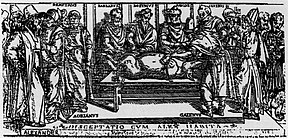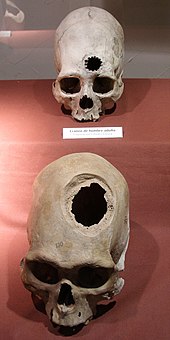History of neurology and neurosurgery
The study of neurology and neurosurgery dates back to prehistoric times, but the academic disciplines did not begin until the 16th century.
The formal organization of the medical specialties of neurology and neurosurgery are relatively recent, taking place in Europe and the United States only in the 20th century with the establishment of professional societies distinct from internal medicine, psychiatry and general surgery.
Trepanation, similar to some techniques used today, is the oldest surgical procedure known and was practised in the Stone Age in many parts of the world,[3] and in some areas may have been quite widespread.
[6] An ancient Egyptian treatise concerning trauma surgery, the Edwin Smith papyrus, contains descriptions and suggests treatments for various injuries, including some of neurological nature.
Buddha's physician, Jīvaka Komārabhacca, performed surgery to remove two parasites from a patient's brain in the 5th century BCE.
Originally, he cut through them accidentally while performing an experiment on the nerves that control breathing by vivisection of a strapped-down, squealing pig.
Galen then performed the same experiment on a variety of animals, including dogs, goats, bears, lions, cows and monkeys, finding similar results each time.
[15] In 1549, Jason Pratensis published De Cerebri Morbis, a volume devoted to neurological diseases, in which he discussed symptoms, as well as ideas from Galen and other Greek, Roman, and Arabic authors.
He had some notions as to brain function, including a vague idea as to localization and reflexes, and described epilepsy, apoplexy, and paralysis.
A hemiplegic patient who could not speak led Paul Broca (1824–1880) to the view that functions in the cerebral cortex were anatomically localised.
The first physicians to devote entirely to neurology were Moritz Heinrich Romberg, William A. Hammond, Duchenne de Boulogne, Jean-Martin Charcot and John Hughlings Jackson.
By the end of the nineteenth century, the connection was established between stroke and hemiplegia, between trauma and paraplegia, between the spirochaete and the paralysed demency people who filled the mental hospitals.
Though it is often said that the development of lobotomy was inspired by the case of Phineas Gage, a railroad worker who had an iron bar driven through his left frontal lobe in 1848, the evidence is against this.
[31][32] Most of these modern tools, like chisels, elevators, forceps, hooks, impactors, and probes, have been in medical practice for a relatively long time.
[33] Other tools such as hand held power saws and robots have only recently been commonly used inside of a neurological operating room.


